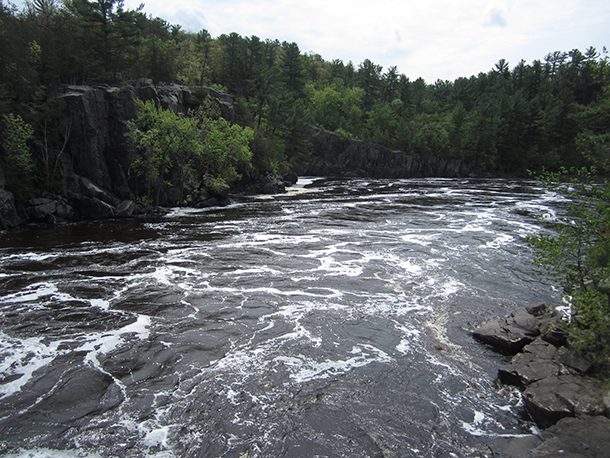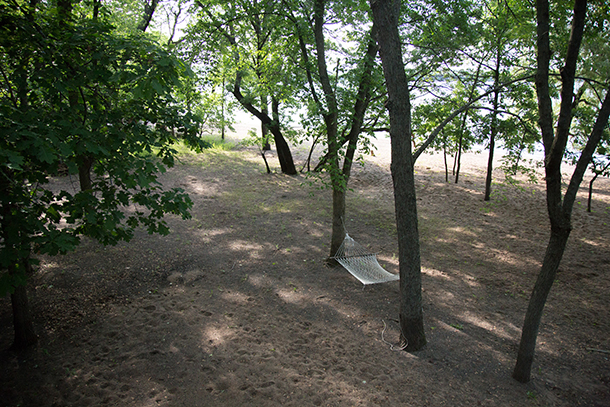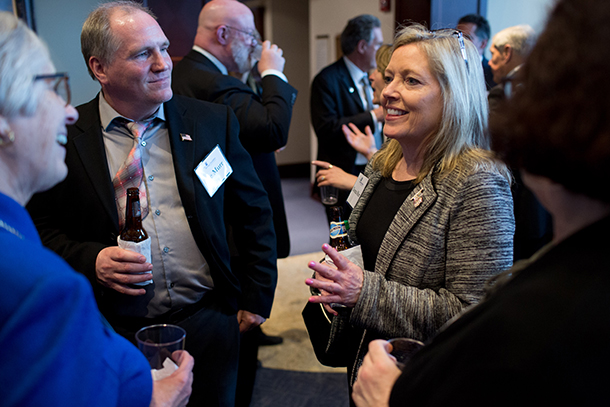Enviro Win at Supreme Court
Air Date: Week of June 30, 2017

The Murr Family property has waterfront along the St. Croix River in Wisconsin, part of the Wild and Scenic Rivers System. (Photo: Ann, Flickr CC BY 2.0)
The US Supreme Court by 5-3 upheld rules that strengthen government powers to regulate private property for environmental reasons. Harvard Law Professor Richard Lazarus, one of the litigators on the winning side of this Wisconsin case, and Living on Earth Host Steve Curwood discuss this decision and how it could also influence land use rules in the future as the planet warms.
Transcript
CURWOOD: From PRI and the Jennifer and Ted Stanley Studios at the University of Massachusetts Boston, this is Living on Earth. I’m Steve Curwood. Environmental regulators and advocates have won a landmark case in front of the Supreme Court of the United States regarding property rights.
The Murr family sued Saint Croix County in Wisconsin in 2013 when regulators refused to issue building permits for two homes along the wild and scenic St. Croix River, which runs through state and national parks. The property was originally purchased in 1963 as two tiny lots, but only one dwelling was ever built, and the county said it was now one small lot. Zoning regulations now designed to protect river ecology prohibited a second home on a single lot, a rule the family said amounted to the taking of some of the value of their property, and thus a violation of property rights.
But the Supreme Court said no, and joining us to discuss the decision is Professor Richard Lazarus of Harvard Law School, who was on the winning side as a lawyer for St. Croix County. Welcome to Living on Earth Professor!
LAZARUS: Delighted to be here.
CURWOOD:First, just explain to us why environmental activists are so concerned about this issue and why they were so happy about the ruling in this case?
LAZARUS: Well, the regulatory takings issue is very important to environmental activists because it's been often used in litigation to challenge environmental restrictions on land use. It's a way to put a brake on these very important restrictions which we've enjoyed in our country now for several decades,
CURWOOD: And just inform us, Professor, what is the takings clause in the United States Constitution? How does it get used in cases like this?
LAZARUS: The Fifth Amendment of the Constitution provides no private property should be taken for public use without just compensation. Most people have fought for centuries that that provision only applied when the government physically took your property, but in 1922, a decision written by no less than Oliver Wendell Holmes, with Louis Brandeis dissenting, the court announced a new constitutional doctrine, and that was one that said that if the government regulates your property to such an extent there's no value left of it, that amounts to a regulatory taking of your property, for which the government has to provide just compensation.
It is actually a doctrine which lay dormant for decades until after the modern environmental law movement of 1970s. When the environmental law movement of the ‘70s passed laws like the Clean Air Act, the Clean Water Act, Endangered Species Act, they started to impose certain restrictions on private individuals use of their land because it basically - Their private use would cause water pollution, air pollution, destroy the habitat of species.
CURWOOD: So, cases have been brought by folks opposed to those regulations saying that they lose partial value of their land, and the government needs to pay them for that. So, there is a spotted owl out on their territory, they can't cut down the tree that they should get paid. They do lose value. I mean, how good is this argument?
LAZARUS: The court said in 1922 was the regulation goes too far. When the economic impact is unduly burdensome that's when there will be a taking. So, it's the question of degree. The environmental restrictions almost never say you can't do anything with any part of your land. What they say is, you can't do something with your most environmentally fragile, sensitive part of your land. So, the question is, how do you measure to what extent the economic impact is? Do you look to the whole parcel, all that they own, or do you just focus on the part of the land which is most restricted by the environmental protection regulation? And that is a big deal when it comes to whether or not people win or lose these takings cases.

A view of the lower half of the Murrs’ riverfront property in Wisconsin. (Photo: PacificLegalFoundation, Flickr CC BY-NC 2.0)
CURWOOD: I gather in the case that you just won in front of the Supreme Court, this was a key issue whether you look at the whole parcel or you look at the piece that you lost. Of course, if I'm the cranky landowner who can't put up a beach house because in the wetlands I'm feeling like I lost all the value of that lot. I was banking on that.
LAZARUS: Absolutely, that's why a lot of very disappointed people in this area. I think the environmentalists respond with say, you don't have a right to build in a wetland, you don't have a right to build in a floodplain, but don't have a right to destroy something which will have a significant adverse impact on other people and on future generations, and that's where the balance comes in. We have to look on the one hand on the degree to which they've been disappointed and whether expectations that they could build are reasonable or not.
CURWOOD: Talk to me about, briefly about the details of this case that you won and what each side was claiming.
LAZARUS: Basically, in this case we had a family, a series of children from the Murr family. Their parents had given them in the 1990s, given two parcels of land right next to each other along a beautiful, the St. Croix River, and the parents have built a small studio, sort of a summer recreational cabin on one of the two parcels, and the Murr children had inherited that from their parents. And they...What they wanted to do was build a house on each parcel. If two different families had owned those two different lots, they could've built a house on each lot even though it would have caused some environmental harm because the government in its grace basically says, “That's too harsh an impact to not let you building anything at all.”
But in this case, the Murrs own both lots, and what government says, in St. Croix County and in counties across the United States for more than 60 years, that if you own two adjoining lots, you're not suffering such a great economic impact because you can still build a house on one lot. We can effectively merge your two lots together. The Murrs said, “That's not fair. We should be able to build a house on each.” The government said, “No, this is perfectly fair. You've had your property diminished in value, but you've not been wiped out. If you haven't been wiped out, it's not a taking.” This is part of the benefits and burdens of living in a civilized society and in having these kinds of environmental restrictions.
CURWOOD: There's a broad conception, Professor, that environmental land use laws reduce property values. When is this true, and when is that not true, and what does this case say in particular about that?
LAZARUS: Environmental protection restrictions are often accused of only eliminating economic value because in the past the court, including the US Supreme Court and certainly the private property plaintiff in these cases, have only focused on the extent to which environmental restrictions decrease value. So somebody, for instance, owns property and they would say, “If I could build whatever I want on this property, the property would be worth a million dollars, but you're only letting me build something much less intensive, and it's only worth $700,000; therefore, you destroyed $300,000 of my value.” But the Supreme Court says here in this case is, “That's not a fair measure of the economic impact environmental protection restriction.”
You also have to look to see what would the value of the property be if those restrictions didn't apply to anybody, not just you, but anybody. If that's the case, it might well be the property is only worth $100,000. So, actually, environmental protection restrictions have decreased the full value you have, but they've also increased the value you have.

Donna Murr at a Heritage Foundation event after arguing the Murr v. Wisconsin and St. Croix County case at the Supreme Court on March 20, 2017. (Photo: PacificLegalFoundation, Flickr CC BY 2.0)
In this case, you have these two pieces of property. They were long and they were very narrow, and they basically were floodplain on the bottom, right next to each other. They then led to a steep slope. You couldn't walk across it, you couldn't transverse it at all, and the top part had a little bit of buildable land. The reason why these little slips of land, mostly floodplain and mostly steep slope, were worth about $400,000 an acre was because it was right next to the St. Croix River, a wild and scenic river, absolutely gorgeous river, right at the bend of the river, and the government had for the past sixty years protected these fragile ecosystems. Yes, it would be worth a little bit more if you could build two houses, but they had property worth $700,000 of the two lots together. That is why, in my view of this case, this was actually not a regulatory takings case. This was a regulatory givings case. And the facts of this case showed how real economic value can be created by sound environmental protection management, and I think the court got that.
CURWOOD: Talk to me about which justices supported the rulings, who dissented, and why.
LAZARUS: We basically won the case five to three. Justice Gorsuch didn't participate because he wasn't yet on the court. Justice Kennedy wrote the majority opinion for the court. He was joined by Ruth Bader Ginsberg, Justice Breyer, Justice Sotomayor, and Justice Kagan. The Chief Justice wrote the dissent in this case joined by Justice Thomas and Justice Alito.
What's interesting about the dissent by Chief Justice is he actually knowledges that under his test the county would probably win on remand, so, even to that extent, it's not clear that any of the eight justices thought the county should lose in this case. He just had a different legal theory.
CURWOOD: So, how tightly closed is the door against this kind of litigation, if the chief justice didn't go along with the majority here?
LAZARUS: Well, the Supreme Court decides thing by majority vote, so it's a five to three. What the Chief Justice said has some force to it, but it's just that. It's a dissent. Justice Kennedy writes the majority opinion. It's a really sweeping ruling. The more interesting question, and some would say the more sobering question going forward, is, given it was that close and there have been rumors of Justice Kennedy leaving the court, it sort of reinforced the notion there's a lot at stake. If Justice Kennedy leaves the court, and there is a lot at stake, if a new justice is appointed to replace Kennedy. Justice Kennedy has been on the court since the late 1980s, he has been in the majority in every single environmental case since he's joined the court except one. He tends to be the bellwether for the Supreme Court on federal constitutional law. He's done that for decades. He did it again in the Murr case.
CURWOOD: So, when the court agreed to take this case up, Justice Scalia was still there. How did his departure, his loss, affect this decision do you think?
LAZARUS: I think there is every reason to think the case probably would be decided exactly the same. But what I can say is the dynamic before the court was very different absent Justice Scalia. My first argument before the US Supreme Court was in October 1986, it was literally just a few weeks after Justice Scalia joined the court. This is the first time I've argued a case when Justice Scalia wasn't on the bench, and it was a very different court, and it felt different. When I argued cases when Justice Scalia was there, especially a case where I was representing an environmental regulator, like a regulatory takings case, Justice Scalia was all over me, all over me from the first second. If I ever was making and scoring good points, he would interrupt me and try to derail me. If he had been on this bench, it would have been a very different argument. At oral argument, no one was challenging me, the way Justice Scalia used to challenge me. No one was bringing up every possible weak point we had in the case, the way Justice Scalia would have done so. This time, I could make my argument, I could make it in full, the court could hear me, and it was a very different experience.

Richard Lazarus is a Professor of Law at Harvard University. (Photo: Courtesy of Harvard Law School)
CURWOOD: So, we're seeing increasingly the effects of global warming, and it’s going to continue to increase. How will this area of the law affect the government response to the challenges of climate change?
LAZARUS: Really in two ways. One way we're going to need more laws to deal with mitigating emissions, to reduce emissions and a lot of those laws reduce emissions will pose restrictions on people who want to use their land in ways that cause air pollution and water pollution. The other way though is that we're going to need climate laws to deal with adaptation. The fact is climate change is going to happen because we’ve not been able to reduce our emissions over the past several decades. That is going to require more land use regulation along the coastlines, in floodplains and wetlands, to try to deal with the adverse effects of having private property development in these increasingly fragile systems along the coastal zones because of climate change. To the extent that we now have a test, a regulatory takings test, which is more sensitive to the need of government to regulate along the coastal zones, that's going to help the government deal with adaptation issues presented by climate change.
CURWOOD: End of the day, this ruling strengthens the position of environmental regulation as compared to before this ruling came along?
LAZARUS: I think it certainly does strengthen it, and that's because in 2003, in the decision called Palazzolo v. Rhode Island, Justice Kennedy, writing for the court, suggested some uncertainty about how you should define the parcel, and he suggested maybe we had to move to a test to redefine the parcel more narrowly. When Kennedy announced that, all environmental regulators sort of took a gasp because, if Justice Kennedy was interested in a test to define a parcel, which was more favorable to private landowners and private property rights advocates, that would be a significant problem for environmental regulation. We've been waiting for basically 14 years to find out the answer to that question. We now have the answer and that is no, they're not going to make that step, and they not only didn't make the step, they actually announced in very broad sweeping turns a new test which is very favorable to government regulation.
CURWOOD: Richard Lazarus is the Howard and Katherine Aibel Professor of Law at Harvard Law School. Thank you so much, Professor.
LAZARUS: Thank you very much.
Links
Living on Earth wants to hear from you!
Living on Earth
62 Calef Highway, Suite 212
Lee, NH 03861
Telephone: 617-287-4121
E-mail: comments@loe.org
Newsletter [Click here]
Donate to Living on Earth!
Living on Earth is an independent media program and relies entirely on contributions from listeners and institutions supporting public service. Please donate now to preserve an independent environmental voice.
NewsletterLiving on Earth offers a weekly delivery of the show's rundown to your mailbox. Sign up for our newsletter today!
 Sailors For The Sea: Be the change you want to sea.
Sailors For The Sea: Be the change you want to sea.
 The Grantham Foundation for the Protection of the Environment: Committed to protecting and improving the health of the global environment.
The Grantham Foundation for the Protection of the Environment: Committed to protecting and improving the health of the global environment.
 Contribute to Living on Earth and receive, as our gift to you, an archival print of one of Mark Seth Lender's extraordinary wildlife photographs. Follow the link to see Mark's current collection of photographs.
Contribute to Living on Earth and receive, as our gift to you, an archival print of one of Mark Seth Lender's extraordinary wildlife photographs. Follow the link to see Mark's current collection of photographs.
 Buy a signed copy of Mark Seth Lender's book Smeagull the Seagull & support Living on Earth
Buy a signed copy of Mark Seth Lender's book Smeagull the Seagull & support Living on Earth

